Text
The 然's
突然,虽然,忽然. and the other 然's can often get mixed up, so here's a quick explanation of some of the most common ones!
突然 (Túrán): This means suddenly or unexpectedly
居然 (Jūrán): This kind of means suddenly, but more in the sense of "surprisingly" or to suggest disbelief at something that happened.
忽然 (Hūrán): This also means suddenly or unexpectedly, but it has a more stronger connotation.
既然 (Jìrán): This is a conjunction meaning "since" or "now that"
既然the weather is great, let's go out!
既然 you aren't busy, let's go watch a movie.
不然 (Bùrán): This means "otherwise" or "or else";
You should study, 不然 you won't do well on the exam.
虽然 (Suīrán): This means although or even though.
虽然 I'm not good at singing, I still like to go to the karaoke.
当然 (Dāngrán): 当然 means certainly or definitely and can be used as a reply:
Can you help me with A? 当然!
自然 (Zìrán): This can mean nature or naturally.
China's 自然 is very beautiful.
She speaks Chinese 得很自然.
仍然 (Réngrán): This can mean "still" or "yet".
I仍然 haven't read that book.
依然 (Yīrán): Similar to 仍然, this also means still" or "yet" but it's usually used in more formal and literary works, whereas 仍然 is more often used in spoken language.
果然 (Guǒrán): 果然 can be used to mean "indeed" or "as expected"
This movie is 果然 interesting.
竟然 (Jìngrán): This is an adverb used to suggest surprise or something unexpected.
He竟然forgot her birthday.
显然 (Xiǎnrán): This means "clearly" or "obviously".
This soup 显然 hot.
偶然 (Ǒurán): This means "accidentally" or "by chance".
We 偶然 met at the same cafe.
How many other 然's do you know about? Drop a comment!
#HOORAY im terrible with the 然s#not rly but the more i learn the more i think im gonna start mixing them up#词汇
257 notes
·
View notes
Text
Can someone explain to me, are alternatively link me to a grammar resource that explains the difference in usage between:
什么都不/没
什么也不/没
一点都不/没
一点也不/没
I've seen all of these pop up as various ways of expressing "not at all." I'm mostly confused about when to use 也 vs 都.
92 notes
·
View notes
Text
Cāi cāi kàn 猜猜看 Have a guess
Chī chī kàn 吃吃看 Have a taste
Shì shì kàn 試試看 Have a try
Qù qù kàn 去去看 Have a look
看起來 Kàn qǐ lái Looks like…
吃起來 Chī qǐ lái Tastes like…
聽起來 Tīng qǐ lái Sounds like…
995 notes
·
View notes
Text
12月27日
我几个月前开始这个博客为了更好学中文,我每天还写日记,但是我最近没写作业,经常忘记生词,怎么办啊
我要养成几个习惯,第一个是每周写作业(很小的目标),第二个是多睡觉,因为我觉得如果我有空,我太累了,就不想学习,所以我要多睡觉
加油自己!我想养成又健康又高兴的习惯
#日记#为什么这么难。。。#im always like this doesn't feel like a hobby it feels like a self imposed obligation :((( WELL. IT WAS A HOBBY AT ONE POINT#i made stupid little comics!!#so i'm busy now and the lessons keep churning on and they get deprioritized. well. um. i should just prepare a text#and read it every day. and organize better. and sleep more. this is totally possible i just need more sleep
6 notes
·
View notes
Text
When you don't recognize a familiar character
Due to different fonts, styles, and variants, sometimes it's hard to recognize a character that you thought you knew well. I collected 3 examples that I've personally encountered online. Let's take a look~
Below, the character in the blue bubble shows what I'm used to seeing.
令 lìng
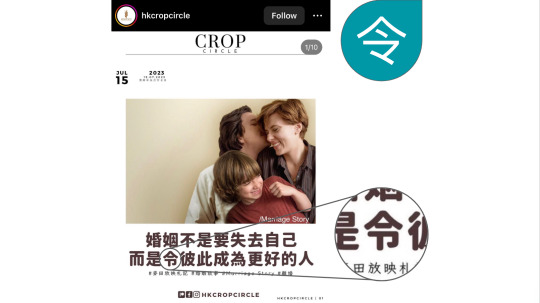
If you look at Wiktionary, you will see that there are a few different styles/versions of the character 令. For instance, you may see the top with a 丶 (点, the dot stroke) or a longer, flat line. But what really threw me off here was the bottom half, which looks quite different here from what I am used to.
灰 huī
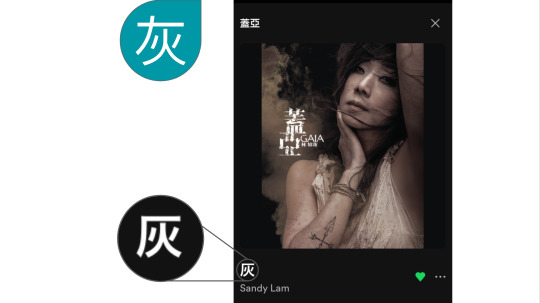
I was so confused by the name of this Sandy Lam song on Spotify. I drew it in Pleco, but I didn't get any matches. I thought maybe it was 灭 miè. Eventually I looked up the album tracklist and learned it's 灰. Wiktionary seems to say this is the Japanese variant of 灰, but I think it comes down to the font Spotify uses.
真 zhēn

Despite 眞 and 真 looking quite different, I actually didn't have much difficulty reading 眞 due to context. MDBG lists it as a variant of 真. This video was on Instagram, but I think it's reposted from 抖音 (Douyin). I see 眞 on a lot of 抖音 reposts, so I assume it's due to the font used on 抖音.
102 notes
·
View notes
Text
10月19日
好久不见!其实我每天睡觉以前还写日记(每天很晚),但是我不贴日记,它们在googledocs。现在我习惯了写日记,所以我觉得中文日记成功了!不需要贴。但是我平常说什么天的活动,不用生词,所以我忘记了生词,这是我的问题。我最近很忙,所以写中文功课很难。
有什么方法?我想用便利贴,把它们贴在柜子上,冰箱上,等等,所以我做每天的活动,可以练习一点。或者我把便利贴在东西上,比如把 "窗户" 放在窗户上。
还可以麻烦学校的中文老师一点,她要求我们每天写五个问题。为了每天用生词,我可以请她看我用上网生词的问题吗?
我想用容易的办法为了记得生词。听中文视频或者看动画都也有用,但没有记得生词的用途。学校越来越难,我越来越忙,所以我不能要求自己用去年的方法,现在那个方法没有用。我就要找新方法为了学习中文。
0 notes
Text
20 measure words (量词) I wish I learned sooner

I've started reading more in Chinese, so I've picked up some new (to me) measure words in the process. I feel like it's easy to become complacent and not learn new measure words. But actually, I've grown to appreciate their specificity and expressiveness.
Here are 20 measure words I wish I had learned sooner. I've also included examples, all of which I've actually encountered IRL.
(1) 架 jià - classifier for planes, large vehicles, radios etc
一架飞机 yí jià fēijī - an airplane
(2) 扇 shàn - classifier for doors, windows etc
一扇门 yí shàn mén - a door
一扇窗 yí shàn chuāng - a window
(3) 丝 | 絲 sī - classifier for a thread (of cloud, smoke etc), a bit, an iota, a hint (of sth) etc
一丝希望 yì sī xīwàng - a shred or glimmer of hope
(4) 枚 méi - classifier for coins, rings, badges, pearls, sporting medals, rockets, satellites etc
一枚弹壳 yì méi dànké - a shell casing
一枚金牌 yì méi jīnpái - a gold medal
(5) 粒 lì - classifier for small round things (peas, bullets, peanuts, pills, grains etc)
一粒沙 yí lì shā - a grain of sand
一粒米 yí lì mǐ - a grain of rice
(6) 阵 | 陣 zhèn - classifier for events or states of short duration
一阵掌声 yí zhèn zhǎngshēng - a burst of applause
一阵风 yí zhèn fēng - a burst of wind
一阵雨 yí zhèn yǔ - a burst of rain
(7) 幅 fú - classifier for textiles or pictures
一幅画 yì fú huà - a painting
(8) 通 tōng - classifier for letters, telegrams, phone calls etc
一通电话 yì tōng diànhuà - a phone call
(9) 副 fù - classifier for pairs, sets of things & facial expressions
一副开心的样子 yí fù kāixīn de yàngzi - a happy look or expression
一副眼镜 yí fù yǎnjìng - a pair of glasses
(10) 艘 sōu - classifier for ships (Taiwan pr. sāo)
一艘船 yì sōu chuán - a boat
(11) 股 gǔ - classifier for smoke, smells etc (thread, puff, whiff) / classifier for sudden forceful actions
一股劲儿 yì gǔ jìnr - a burst of energy
一股臭味 yì gǔ chòuwèi - a whiff of a bad odor
(12) 名 míng - classifier for people
一名演员 yì míng yǎnyuán - an actor
一名歌手 yì míng gēshǒu - a singer
(13) 盏 | 盞 zhǎn - classifier for lamps
一盏灯 yì zhǎn dēng - a lamp
(14) 缕 | 縷 lǚ - classifier for wisps (of smoke, mist or vapor), strands, locks (of hair)
一缕头发 yì lǚ tóufa - a strand of hair
(15) 根 gēn - classifier for long slender objects, e.g. cigarettes, guitar strings
一根烟 yì gēn yān - a cigarette
一根葱 yì gēn cōng - a scallion
(16) 对 | 對 duì - classifier for a couple or a pair
一对夫妻 yí duì fūqī - a pair of husband and wife
一对夫妇 yí duì fūfù - a pair of husband and wife
(17) 份 fèn - classifier for gifts, newspaper, magazine, papers, reports, contracts etc
一份报告 yí fèn bàogào - a report
一份工作 yí fèn gōngzuò - a job
(18) 级 | 級 jí - classifier for steps, levels
一级台阶 yì jí táijiē - a step or stair
(19) 道 dào - classifier for long thin things (rivers, cracks etc), barriers (walls, doors etc), questions (in an exam etc)
一道墙 yí dào qiáng - a wall
一道门 yí dào mén - a door
一道题 yí dào tí - a question or exercise
一道河 yí dào hé - a river
一道缝隙 yí dào fèngxì - a crack
(20) 支 zhī - classifier for army divisions and for songs or compositions
一支队伍 yì zhī duìwǔ - a team
一支乐曲 yì zhī yuèqǔ - a musical composition
Definitions are adapted from MDBG.
See similar posts:
"Bare" measure words (classifiers without demonstratives and numerals)
272 notes
·
View notes
Note
hey (culture ask incoming) im wondering about weddings in china and whether people generally wear more western style wedding clothes or traditional chinese style?
(Long-winded answer incoming)
Depends.
I would say Chinese/hanfu style wedding attire has been making a big comeback (so to speak) in recent years as a side effect of the hanfu revival movement, but there is also Chinese wedding attire that is distinctly it's own genre of clothing, i.e, bridal/groom wear. When you look at it, you know (if you know) that it's wedding attire. More on this in a second.
Still, for those who can afford it, it is popular these days to wear both western style wedding attire and Chinese wedding attire. Most people who I've seen wear both change into the Chinese attire for the wedding banquet. If they wear a western wedding dress, it will be at the ceremony/walking down the aisle. Likewise, if they wear both hanfu and Chinese wedding attire, they will wear the hanfu for the ceremony. Another thing to keep in mind is that in China, it is quite popular to take wedding photos in a myriad of outfits, not just the one you will be wearing on the occasion. So people nowadays may take photos in all the different kinds of wedding attire (via clothing rentals), whether they are going to wear it at their wedding or not. In that spirit, they still technically wear both western and Chinese style wedding clothes.
Hopefully that answers your question there. I have a #chinese wedding that covers a lot of videos but in which you can see the types of gowns and all that which I will briefly go into below.
So: when it comes to "traditional Chinese style" wedding attire, what does that really mean?
To me, three main types of clothing come to mind: 1) Chinese Wedding Attire™ , 2) Chinese style wedding attire, 3) Wedding hanfu
1) Chinese Wedding Attire™, AKA 秀禾服 Xiùhé
Visually distinct, it is not really hanfu nor qizhuang but a secret third thing.... In this case, it is a blend of Qing dynasty and Republican era styles dubbed "xiuhe". As bridal wear specifically, it is actually a rather recent trend (21st century), but it's become a fixture in Chinese wedding wear. While the colors can vary wildly and magnificently, the classic colors here are gold and red.
The style that exists today shows Qing dynasty influence in its construction and at its core consists of both bride and groom wearing embroidered tang suit tops and a matching silk skirt. The bride usually wears hair ornaments/pins in place of a veil. Since there are pins in the hair, brides may wear a xiapei/cape with a long train instead.
A few bridal styles (keep in mind that these are just the classic cuts and colors—there are other styles/colors are contain recognisable elements of bridal wear but are made of different fabrics, have different draping, have more tassels, have a softer look, etc):



2) Chinese style wedding attire
This is admittedly somewhat of the same thing as Wedding Attire™, just toned down as it was more popular/commonplace in the last century, when it was what was most affordable for most, but it's a style that nonetheless comes to mind. With this, the key is simply that the bride wears a mostly all red dress/top+skirt and the groom wears a suit. Bride and groom will also often wear a red flower/ribbon pinned to their top or worn around them gift-wrapped style, haha. My mom just wore a red top and bottom to her wedding dinner (that's as much detail as I've ever gotten out of her lol) when she got married in the early 80s. Another thing is, since white is a funerary color/color of death in Asian cultures, some people also just wear Western style wedding dresses that are red.
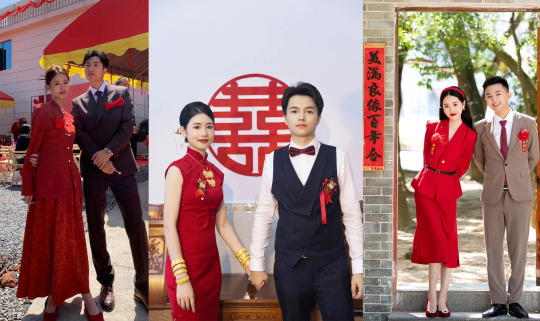

3) Wedding hanfu
As you can imagine, this is ornate hanfu that is worn for weddings. Song/Ming style hanfu is particularly popular here.This clothing is traditional in the sense that it has historical basis and is what those who could afford to word for weddings historically. Historical wedding colors varied but color pairings like red & blue and red & green are traditional (man wears red, woman wears blue/green; 红男绿女). Wearing hanfu for weddings is a trend that has become popular with the hanfu revival movement and is, as you might guess, a trend for Han Chinese people
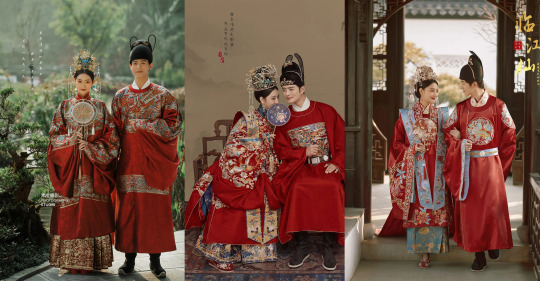
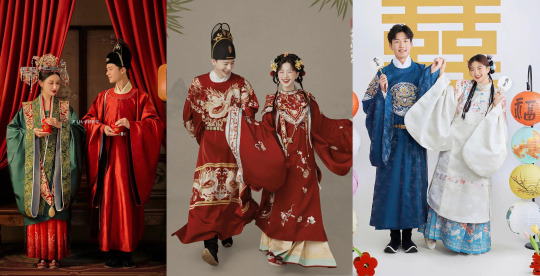

Chinese ethnic minorities have their own wedding attire that they may choose to wear/wear as well (if they do a banquet, etc). Or they might just wear red/xiuhe/western style dresses, too—this is another area where wedding photos let you basically wear everything.
(just a few examples:)
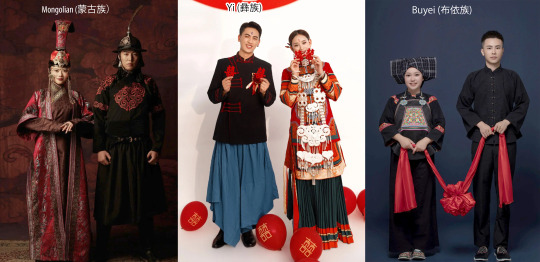

2K notes
·
View notes
Text
Chinese characters that I mix up
During the course of my Mandarin studies, I have run into several characters that I mix up because they either look similar to others or are polyphones and homographs, that is, words that can be pronounced in more than one way and thus have more than one meaning. The former are known as 多音字 (duōyīnzì) in Mandarin. These are some of them:
长 (cháng/zhǎng): long/to grow
了 (liǎo/le): to be finished/used to indicate perfective aspect or a change of state
认为 (rènwéi) vs. 以为 (yǐwéi): “to believe” vs. “to mistakenly believe”
着 (zháo/zhe): to burn/particle that indicates the continuation of an action or a state
While doing research for this post, I also found the following commonly-used 多音字:
的 (de/dī/dí/dì): particle to express possession/taxi (的士, dīshì)/really (的确, díquè)/purpose(目的, mùdì)
发 (fā/fà): to shoot/hair
干 (gān/gàn): dry/to do
好 (hǎo/hào): good/to be fond of
几 (jī/jǐ): small table/a few
乐 (lè/yuè): music/happiness
行 (xíng/háng): to go/profession
中 (zhōng/zhòng): middle/to hit the mark
If you are interested in this topic, this site has a very comprehensive list of 多音字 and their different meanings.
86 notes
·
View notes
Text
9月11日
n/a
今天我有多多多功课。。。。我还没都写完了,我写什么就可以但是我觉得我不准备够了。。。历史课太难了。我没有空~ 我不喜欢 :(
1 note
·
View note
Text
9月10日
practiced reading with grandma
今天婆婆再来我家,我和她和弟弟一起打麻将。我和婆婆看我的人中文课本,练习读,一起写我明天的五个问题。爸爸来家以后,我们去公园,我爬树,很好玩。
1 note
·
View note
Text
9月9日
n/a
我今天写组织计划。我想知道,什么是最好的做功课计划?所以我几个办法。我一个星期去图书馆写功课,一个星期听下雨视频,等等。好像科学,我喜欢!我星期一开始。今天也是我婆婆的生日,我、妈妈、弟弟、婆婆、公公、和姨姨都去火锅餐厅,非常好吃!吃火锅后,我们吃冰激凌<3
0 notes
Text
9月8日
online class: 环保时装秀(上)(?)
今天我写日记这么早因为我一点懊恼。复习词汇不太好。。。我忘了多词汇,所以我每周学得不够。我怎么学习更好?写别的功课也不很好,但我想取得成功,所以我的问题不是写功课一次,我想每天学得很好。可以吗?我小的时候没有问题,现在我又忙又累,所以组织不太好了。好吧!为了不忘记,我去完成中文作业。
+ 为了更经常看日记,我昨晚把日记放在docs,这是很方便 :)看日记的时候,我看了很多错误。。。电脑不知道我想用什么字,对不起!我必须再看一次每一个帖子。
1 note
·
View note
Text
9月7日
finished chinese hw
我没忘记了昨天的日记。。。只太晚了。我刚刚告诉我妈妈:学中文不太难,但是我希望我学得更好,更有意思。我每周上课前一天写作业,我不喜欢这个坏习惯。我也每天写日记在晚上,太晚了!我妈妈说,生活像马拉松赛。如果我的成绩不错,我长大的时候可以学中文因为生活很长的,有多多时间,所以别着急吧!我觉得这个计划很好。其实我很忙,学校不太难,但我想做很多的活动,都有意思,所以我没有时间。如果我的中文越来越好,我每周学够了!
1 note
·
View note
Text
Do you really know the meaning of a word?
Learning Chinese is a journey that never ends! Sometimes you think you know a word, but then you find out that it has another meaning or usage that you didn't even know about.
Here are some words that I thought I knew but evidently didn't know well enough! The bolded text represents the meaning(s) I was not familiar with.
家教 jiājiào - family education / upbringing / to bring sb up / private tutor
后天 | 後天 hòutiān - the day after tomorrow / life after birth (the period in which one develops through experiences, contrasted with 先天) / acquired (not innate or congenital) / a posteriori
生气 | 生氣 shēngqì - to get angry / to take offense / angry / vitality / liveliness
组织 | 組織 zǔzhī - to organize / organization / (biology) tissue / (textiles) weave
明白 míngbai - clear / obvious / unequivocal / to understand / to realize
冒险 | 冒險 màoxiǎn - to take risks / to take chances / foray / adventure
My emotional state throughout can be described as: confusion, betrayal, and finally acceptance.
See similar posts:
Characters with other meanings that surprised me
242 notes
·
View notes
Text
9月5日
n/a
我最近在历史课和着急。。。因为我上星期上课,所以我没学习第一和二星期的思想。明天我请���师帮我明白这节课。我们现在学习中国! 我认识一点孔夫子和老子的思想,所以不太难
1 note
·
View note
Text
9月4日
n/a
我还没写中文作业。。。但我不太忙了?我不知道为什么我每星期迟的。我要组织活动。今晚还有一点时间,我去写一下作业
1 note
·
View note